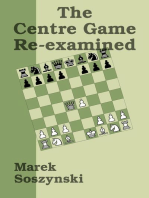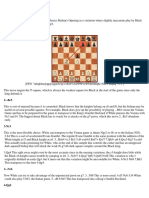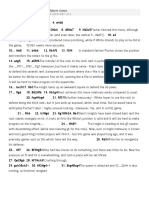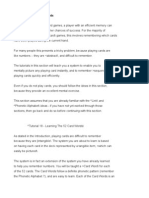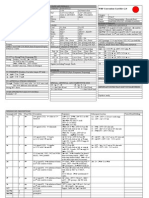100%(1)100% found this document useful (1 vote)
119 viewsTwo Knights Defense
Two Knights Defense
Uploaded by
William Alberto Caballero RoncalloThis document provides a summary of two chess games:
1) The first game is between Hans Berliner and Larry Evans from the 1947 U.S. Junior Championship. It analyzes the King's Gambit Declined opening and Berliner's win with tactic involving a queen sacrifice.
2) The second game is between Larry Evans and Arthur Bisguier from the 1959 U.S. Championship. It provides a commentary on Evans' attack in the Petrov Defense opening and his victory over Bisguier while encouraging readers to try guessing Evans' moves.
Copyright:
© All Rights Reserved
Available Formats
Download as DOCX, PDF, TXT or read online from Scribd
Two Knights Defense
Two Knights Defense
Uploaded by
William Alberto Caballero Roncallo100%(1)100% found this document useful (1 vote)
119 views4 pagesThis document provides a summary of two chess games:
1) The first game is between Hans Berliner and Larry Evans from the 1947 U.S. Junior Championship. It analyzes the King's Gambit Declined opening and Berliner's win with tactic involving a queen sacrifice.
2) The second game is between Larry Evans and Arthur Bisguier from the 1959 U.S. Championship. It provides a commentary on Evans' attack in the Petrov Defense opening and his victory over Bisguier while encouraging readers to try guessing Evans' moves.
Original Description:
Ajedrez
Copyright
© © All Rights Reserved
Available Formats
DOCX, PDF, TXT or read online from Scribd
Share this document
Did you find this document useful?
Is this content inappropriate?
This document provides a summary of two chess games:
1) The first game is between Hans Berliner and Larry Evans from the 1947 U.S. Junior Championship. It analyzes the King's Gambit Declined opening and Berliner's win with tactic involving a queen sacrifice.
2) The second game is between Larry Evans and Arthur Bisguier from the 1959 U.S. Championship. It provides a commentary on Evans' attack in the Petrov Defense opening and his victory over Bisguier while encouraging readers to try guessing Evans' moves.
Copyright:
© All Rights Reserved
Available Formats
Download as DOCX, PDF, TXT or read online from Scribd
Download as docx, pdf, or txt
100%(1)100% found this document useful (1 vote)
119 views4 pagesTwo Knights Defense
Two Knights Defense
Uploaded by
William Alberto Caballero RoncalloThis document provides a summary of two chess games:
1) The first game is between Hans Berliner and Larry Evans from the 1947 U.S. Junior Championship. It analyzes the King's Gambit Declined opening and Berliner's win with tactic involving a queen sacrifice.
2) The second game is between Larry Evans and Arthur Bisguier from the 1959 U.S. Championship. It provides a commentary on Evans' attack in the Petrov Defense opening and his victory over Bisguier while encouraging readers to try guessing Evans' moves.
Copyright:
© All Rights Reserved
Available Formats
Download as DOCX, PDF, TXT or read online from Scribd
Download as docx, pdf, or txt
You are on page 1of 4
Two Knights Defense
Donnelly Ford
Houston, Texas
Q: In the Two Knights Defense, BCO (page
314) gives the Berliner variation:
1. e4 e5 2. Nf3 Nc6 3. Bc4 Nf6 4. Ng5 d5 5.
exd5 Nd4 6. c3 b5 7. Bf1 Nxd5 8. Ne4 Qh4!
r+l+kvl-tr
zp-zp-+pzpp
-+-+-+-+
+p+nzp-+-
-+-snN+-wq
+-zP-+-+-
PzP-zP-zPPzP
tRNvLQmKL+R
After 8. ... Qh4
Instead of 9. Ng3 Bg4 10. f3 e4!, the
book makes no reference to 9. d3 Ne6 10.
g3 Qd8 11. Bg2 with which I beat my
Novag computer in 55 moves. Is 9. d3 an
improvement for White?
A: After 9. d3 Bg4! 10. Qd2 Ne6 material
is even and Black has a nice lead in development.
In his famous postal game with
Estrin in 1968 (see game 100 in my book
Modern Chess Brilliancies), Berliner writes:
“8. ... Qh4 was condemned in every opening
book despite its natural appearance
and its function in helping to keep White
off balance. The recommended move is 8.
... Ne6 which leads to equal positions.
This in itself is enough to censure the
whole variation for White.” But your question
raises another fertile area of
discussion: Is 4. Ng5 really good, and
can White get any concrete advantage
against the Fritz Variation (5. ... Nd4)?
In addition to the main line, ECO, section
C57 also gives 8. cxd4 Qxg5 9. Bxb5+
Kd8 10. Qf3 Bb7 leading to equality. Yet
no mention is made of Fischer-N.N., Montreal
simul, 1964, which continued: 11. 0-0 e4!? 12. Qxe4 Bd6 13. d3? (necessary
is 13. Re1! c6 14. Bf1) and now Fischer
pointed out that Black missed a neat coup
with 13. ... Bxh2+! 14. Kxh2 Nf4!! 15.
Bxf4 Qh4+ 16. Kg1 Bxe4, etc. This was
mentioned in Keres’ older Dreispringerspeil
bis Konigsgambit, but didn’t make it
to ECO—an example of the manner in
which things are lost as well as gained
with each advance of opening theory.
Chess politics was as much a topic of
discussion in the column as was opening
theory. Evans pulled no punches in discussing
FIDE. Here is an example from
ten years ago in the March 2001 issue:
King’s Gambit Declined (C30)
Hans Berliner
Larry Evans
U.S. Junior Championship, 1947
1. e4 e5 2. Nc3 Nf6 3. Bc4 Bc5 4. f4 d6 5. Nf3
Nc6 6. d3 Be6!? 7. Bb5! a6 8. Bxc6+ bxc6 9.
f5 Bd7 10. h3 h5 11. Qe2 Qb8! 12. Bd2 Ba7
13. b3 Qb7 14. Ng5 Bd4! 15. 0-0-0 a5 16. Nf3
c5! 17. a4 Rb8 18. g4
Here he played ...
18. ... c4!
... based on 19. bxc4 Qb2 mate as well
as the less-obvious 19. dxc4 Bxc3 20.
Bxc3 Nxe4.
White replied with tactics:
19. Nxd4 exd4 20. e5 but this was refuted by
20. ... cxd3! 21. cxd3 (21. Qxd3 dxc3) 21. ...
Qxb3 22. exf6+ Kd8 23. Bg5 Qa3+! 24. Kd2
Qxc3 mate.
Petrov Defense (C42)
Larry Evans
Arthur Bisguier
U.S. Championship, 1959
1. e4 e5 2. Nf3 Nf6 3. Nxe5 d6 4. Nf3 Nxe4 5.
c4 d5 6. Nc3 Bc5 7. d4 Bb4
r_nl_qk+ _r
_pp_p +p_pp
+ + + +
+ +p+ +
_lP_Pn+ +
+ _N +N+
P_P + _PP_P
_R _LQ_KL+R
Your starting position
Now make sure you have the above
position set up on your chessboard. As
you play through the remaining moves in
this game, use a piece of paper to cover
the article, exposing White’s next move
only after trying to guess it. If you guess
correctly, give yourself the par score.
Sometimes points are also rewarded for
second-best moves, and there may be
bonus points—or deductions—for other
moves and variations. Note that ** means
that the note to Black’s move is over and
White’s move is on the next line.**
8. Qb3 Par Score: 5
Settle for only 4 points part credit if
you defended 8. Bd2. Accept 1 bonus
point if you saw that 8. Qa4+ is met by 8.
... Nc6.
8. … c5
Black guards the bishop and opens a
path for the queen.**
9. Bd3 Par Score: 5
Receive only 4 points part credit for 9.
cxd5.
9. … Qa5
This is the logical follow-up to his previous
move. The point c3 is threatened
once again.**
10. 0-0 Par Score: 6
White is not worried about the loss of
a pawn, Evans gets his king to safety.
Note that while this is a gambit it is not
the Evans Gambit (Named for the 19th
century Welsh sea captain, not GM
Evans).
10. … Nxc3
11. bxc3 Par Score: 4
11. … Bxc3
Black accepts the pawn sac because he
has nothing better.**
12. Bb2 Par Score: 5
Accept 1 bonus point if you intended
this move when castling.
12. … Bxb2
Black must give up control of e1, since
12. ... Bb4 runs into 13. a3, winning a
piece (1 bonus point).**
13. Rae1+ Par Score: 6
White may delay recapture while he
checks the king (2 bonus points for seeing
it in advance).
13. … Kf8
Add 1 bonus point if you saw that 13.
... Be6 is met by 14. cxd5!.**
14. Qxb2 Par Score: 4
It’s time to take back. No credit for anything
else. It’s also time to take inventory.
Black has an extra pawn, but in return
his king has lost the castling privilege.
Add to this that White has a clear lead in
development. Overall, it’s White for choice.
Accept 1 bonus point if you so evaluated.
14. … cxd4
This clears the center.**
15. cxd5 Par Score: 5
15. … Nd7
Receive 1 bonus point if you saw that
Black gets mated after 15. ... Qxd5 16.
Qb4+ and Re8.**
16. Qxd4 Par Score: 5
16. … Nf6
Black guards e8 and opens a path for
his bishop. He could also have tried 16.
... Qc5 and then 17. ... Nf6, reversing the
move order of the game.**
17. Qe5 Par Score: 5
White threatens mate in three after 18.
Qe7+ Kg8 19. Qe8+ etc. (1 bonus point if
you had this in mind).
17. … Qc5Black doesn’t allow the white queen to
penetrate.**
18. Ng5 Par Score: 5
Award 1 bonus point for seeing the
threat: 19. Nxh7+ Rxh7 (19. ... Nxh7 20.
Qe8 mate) 20. Bxh7.
18. … Bd7
Bisguier meets the threat by guarding
the back rank.**
19. Ne4 Par Score: 6
This forces the exchange of the f6-
knight, Black’s best defender.
19. … Nxe4
The try 19. ... Qxd5 fails to 20. Nxf6
Qxe5 21. Nxd7+ and 22. Nxe5.**
20. Rxe4 Par Score: 4
This clears the e1-square for the doubling
of rooks.
20. … Re8
Bisguier has managed to get his queenrook
out of the corner. Unfortunately,
the king-rook presents its own special
problems.**
21. Qf4 Par Score: 5
Accept only 3 points part credit for 21.
Qd4, preserving the d5-pawn, but allowing
the exchange of queens, which relaxes
the pressure. Evans rightly prefers keeping
queens on the board.
21. … Qxd5
If he’s going to suffer, Black at least
wants a pawn for his troubles. And if
White misplays the attack, the extra pawn
can play a role in the endgame.**
22. Rfe1 Par Score: 5
White has accomplished the doubling
of the rooks and threatens a back row
mate: 23. Rxe8+ Bxe8 24. Qb4+ and Rxe8
mate. Add 1 bonus point, even though
we’ve seen this pattern before.
22. … Rxe4
With mate in the air, the d3-bishop is
immune to capture.**
23. Bxe4 Par Score: 4
Accept only 3 points part credit for 23.
Qxe4, allowing Black to trade queens.
Black cannot afford 23. ... Qxa2 because
of 24. Qd6+ Kg8 25. Qb8+ (1 bonus point).
23. … Qe6
Black can’t stop Qb8+, so he pins the
bishop and aligns with the a2-pawn.**
24. Qb8+ Par Score: 5
This forking check will recover one
pawn and menace another.
24. … Be8
Nor does 24. ... Qe8 change the picture
in any essentials. If anything, it places the
queen in a more passive position.**
25. Qxa7 Par Score: 5
Now if White gets the b7-pawn he’ll
have a passed a-pawn to march down
the board. Accept 1 bonus point if you
noticed that 25. ... f5 is answered by 26.
Qc5+ Qe7 (26. ... Kf7[g8] 27. Bd5) 27.
Qxf5+. If 25. ... Bc6 simply 26. Qb8+.
25. … b6
This preserves the pawn. A better practical
chance was 25. ... g6, making an
outlet for the king.**
26. Qa3+ Par Score: 5
Accept 1 bonus point for seeing 26. ...
Kg8 27. Bxh7+.
26. … Qe7
27. Bc6 Par Score: 5
A pretty finish: If 27. ... Qxa3, then 28.
Rxe8 mate. Accept only 3 points part
credit for 27. Qxe7+ and 28. Bxh7+.
27. … Black resigned.
You might also like
- 7 Wonders Architects Rules ENGDocument2 pages7 Wonders Architects Rules ENGmrsvertrauenNo ratings yet
- Davies N The Nimzo Indian and Queen's Indian Defences 2021Document532 pagesDavies N The Nimzo Indian and Queen's Indian Defences 2021carlosdavisora100% (3)
- Ed Marlo - Revolutionary Card TechniqueDocument511 pagesEd Marlo - Revolutionary Card TechniqueKathleen Montgomery100% (18)
- The Chigorin Defense Agains The LondonDocument8 pagesThe Chigorin Defense Agains The LondonGerardoIbarra100% (1)
- Eric Schiller - Sicilian Wing GambitDocument1 pageEric Schiller - Sicilian Wing GambitFadil Habibi Danufane100% (1)
- Sicilian O'Kelly VariationDocument21 pagesSicilian O'Kelly VariationJuan Andres Auernheimer100% (2)
- S. Bücker & C. Galofre - Chess Cafe - Over The Horizons - 1-74Document599 pagesS. Bücker & C. Galofre - Chess Cafe - Over The Horizons - 1-74Paulino Aguilera Malagón100% (3)
- The Instructor 95 - Critical Moments 2Document10 pagesThe Instructor 95 - Critical Moments 2William Alberto Caballero RoncalloNo ratings yet
- Learning Chess: Manual For Chess TrainersDocument12 pagesLearning Chess: Manual For Chess TrainersDr Khant Thu Maung0% (1)
- Catan 2 Player Scenario enDocument2 pagesCatan 2 Player Scenario enAdrian Salamon0% (1)
- David Cummings - Opening Repertoire The English (2016) TinyDocument392 pagesDavid Cummings - Opening Repertoire The English (2016) TinyCarlos Alejandro Chavez100% (17)
- Zlatanovic - Fundamental Chess Strategy in 100 Games (2020)Document1,088 pagesZlatanovic - Fundamental Chess Strategy in 100 Games (2020)Alex100% (9)
- Scotch Latest GamesDocument11 pagesScotch Latest GamesManumona100% (1)
- French Wing Gambit GameDocument226 pagesFrench Wing Gambit Gamerafachess6388No ratings yet
- Meran With 8. Be2Document17 pagesMeran With 8. Be2Marcos PiñaNo ratings yet
- Clyde Nakamura GambitsDocument13 pagesClyde Nakamura Gambitsmpollinni100% (1)
- The Openings Explained: Scandinavian With 2... Nf6 (B01)Document14 pagesThe Openings Explained: Scandinavian With 2... Nf6 (B01)chandra686550% (2)
- Modern Steinitz KeresDocument43 pagesModern Steinitz KeresMarko Jooste100% (1)
- Scacchi - (Chess) Unorthodox Openings Newsletter 11Document50 pagesScacchi - (Chess) Unorthodox Openings Newsletter 11japov100% (2)
- The Kahiko-Hula Franco - Hiva GambitsDocument30 pagesThe Kahiko-Hula Franco - Hiva GambitsmpollinniNo ratings yet
- Good Openings For BishopDocument10 pagesGood Openings For BishopMahavir JainNo ratings yet
- E. Schiller & B. Colias - How To Play Black Against The Staunton GambitDocument146 pagesE. Schiller & B. Colias - How To Play Black Against The Staunton GambitArhireVasile100% (2)
- The Blumenfeld Gambit (E10) PDFDocument10 pagesThe Blumenfeld Gambit (E10) PDFMiguel Angel Varela LópezNo ratings yet
- Positonal Concept: Blockade: 07/09/15 10:26 PM Positional Theme: BlockadeDocument2 pagesPositonal Concept: Blockade: 07/09/15 10:26 PM Positional Theme: Blockadenikhil4tp100% (1)
- Andrew Martin - Scandinavian Surprise (TWIC Theory - 1)Document11 pagesAndrew Martin - Scandinavian Surprise (TWIC Theory - 1)beetletremembe100% (1)
- Martin - Scandinavian SurpriseDocument11 pagesMartin - Scandinavian Surpriseanon-355439100% (2)
- The Pawn CenterDocument16 pagesThe Pawn CentersunivaguNo ratings yet
- Russia Cup 2018 Nabaty, Tamir (Israel) - Lomasov, Semen (Russia) Russia Cup Stage 2018Document10 pagesRussia Cup 2018 Nabaty, Tamir (Israel) - Lomasov, Semen (Russia) Russia Cup Stage 2018Werton Alvarenga BastosNo ratings yet
- The English - Move by Move - Ebcafe09 PDFDocument6 pagesThe English - Move by Move - Ebcafe09 PDFAnonymous kdqf49qb100% (1)
- Tactics in the Chess Opening 3: French Defence and other half-open gamesFrom EverandTactics in the Chess Opening 3: French Defence and other half-open gamesRating: 5 out of 5 stars5/5 (1)
- Chess Strategy Englund 1d4 E5 How To Beat Intermediate Chess Players - Tim SawyerDocument147 pagesChess Strategy Englund 1d4 E5 How To Beat Intermediate Chess Players - Tim SawyerthowabenedictNo ratings yet
- English Opening: Beating The Popular 4 Bc5 SystemDocument16 pagesEnglish Opening: Beating The Popular 4 Bc5 SystemGopi KrishnaNo ratings yet
- Game01 - Steinitz, William - Janowski, Dawid MarkelowiczDocument10 pagesGame01 - Steinitz, William - Janowski, Dawid Markelowiczstrastunn100% (1)
- Kortschnoj, Viktor vs. Fischer, Robert James: Herceg Novi Blitz - Herceg Novi - 1970 - ECO: E97 - 0-1Document4 pagesKortschnoj, Viktor vs. Fischer, Robert James: Herceg Novi Blitz - Herceg Novi - 1970 - ECO: E97 - 0-1Ernest WongNo ratings yet
- Nc3 d5 SidelinesDocument12 pagesNc3 d5 SidelinesNick Voudouris100% (1)
- Efstratios Grivas - Pawns On The Same RankDocument9 pagesEfstratios Grivas - Pawns On The Same Rankpavel_janda_3No ratings yet
- Evans Gambit - How To Win in Chess Openings - Tim Sawyer - Anna's ArchiveDocument164 pagesEvans Gambit - How To Win in Chess Openings - Tim Sawyer - Anna's ArchiveAd SoyadNo ratings yet
- Treasure Island: Opening LanesDocument11 pagesTreasure Island: Opening LanesAndrew Wooten100% (1)
- Chess Evolution Weekly Newsletter Issue 64Document30 pagesChess Evolution Weekly Newsletter Issue 64Juan Leon100% (1)
- Twic Theory: Trompowsky Attack Black Gets CreativeDocument11 pagesTwic Theory: Trompowsky Attack Black Gets CreativefdtamayophNo ratings yet
- b22 Sicilian Alapin by GM SveshnikovDocument42 pagesb22 Sicilian Alapin by GM SveshnikovAlexandre Atlas100% (1)
- Chess 5Document10 pagesChess 5Valerij DragicevicNo ratings yet
- The Openings Explained: The French Exchange (C01)Document10 pagesThe Openings Explained: The French Exchange (C01)Charles Lucas100% (1)
- SpanishchainsDocument6 pagesSpanishchainsFischer BobbyNo ratings yet
- Game 59Document22 pagesGame 59Holy QuranNo ratings yet
- Sicilian Najdorf (English Attack 6... Ng4)Document9 pagesSicilian Najdorf (English Attack 6... Ng4)Mt's Rodrigo100% (1)
- Beating The AntiDocument48 pagesBeating The AntiGopi KrishnaNo ratings yet
- Andrei Volokitin Vs Shakhriyar MamedyarovDocument7 pagesAndrei Volokitin Vs Shakhriyar Mamedyarovbartsch6No ratings yet
- Winning Ugly - Davies18 PDFDocument6 pagesWinning Ugly - Davies18 PDFAnonymous kdqf49qbNo ratings yet
- Side-Stepping Mainline Theory Cut Down On Opening Study and Get A Middlegame You Are Familiar With - 44-86 - 1-11Document11 pagesSide-Stepping Mainline Theory Cut Down On Opening Study and Get A Middlegame You Are Familiar With - 44-86 - 1-11schmidt0% (1)
- 31 Free Lessons by GM Tejas Bakre, Cyberchess Lectures, 2008 - ChessDocument58 pages31 Free Lessons by GM Tejas Bakre, Cyberchess Lectures, 2008 - ChessAdarsh TripathiNo ratings yet
- The Instructor: Opening CatastrophesDocument9 pagesThe Instructor: Opening CatastrophesFuad AkbarNo ratings yet
- The Philidor Defense (C41) - Abby18 PDFDocument12 pagesThe Philidor Defense (C41) - Abby18 PDFAnonymous kdqf49qb100% (2)
- The KibitzerDocument62 pagesThe KibitzerpjblkNo ratings yet
- Active Against CatalanDocument7 pagesActive Against CatalanZisisNo ratings yet
- The Openings ExplainedDocument15 pagesThe Openings Explained46sdftNo ratings yet
- Mcgrew 35Document12 pagesMcgrew 35098hji76543bhr4zhNo ratings yet
- Specialized Chess Opening Tactics – Budapest & Fajarowicz Gambits: Specialized Chess Tactics, #1From EverandSpecialized Chess Opening Tactics – Budapest & Fajarowicz Gambits: Specialized Chess Tactics, #1Rating: 5 out of 5 stars5/5 (1)
- A Spanish Repertoire For Black: Update ToDocument25 pagesA Spanish Repertoire For Black: Update ToradovanbNo ratings yet
- Tactics in the Chess Opening 1: Sicilian DefenceFrom EverandTactics in the Chess Opening 1: Sicilian DefenceRating: 3.5 out of 5 stars3.5/5 (2)
- Scandinavian Portuguese VariationDocument3 pagesScandinavian Portuguese VariationPavelNo ratings yet
- SokolskyDocument25 pagesSokolskyLucasNo ratings yet
- b6 Eng PDFDocument7 pagesb6 Eng PDFsupramagusNo ratings yet
- From Chapter 1 The Slav Defense: Game # 23 H.Teske (2550) - T.Jugelt (2400) D17Document16 pagesFrom Chapter 1 The Slav Defense: Game # 23 H.Teske (2550) - T.Jugelt (2400) D17phamvanloc06012007No ratings yet
- Extracted Pages From Solitaire Chess - Bruce PandolfiniDocument13 pagesExtracted Pages From Solitaire Chess - Bruce PandolfiniNicolás Riquelme AbuffonNo ratings yet
- Chess TrapsDocument9 pagesChess TrapsRATHEESH P.KNo ratings yet
- British Chess Magazine - November 2019 PDFDocument64 pagesBritish Chess Magazine - November 2019 PDFWilliam Alberto Caballero Roncallo100% (3)
- Tkachenko 4 - Rook - Puzzles To SolveDocument17 pagesTkachenko 4 - Rook - Puzzles To SolveWilliam Alberto Caballero RoncalloNo ratings yet
- Chess Dvoretsky 25Document16 pagesChess Dvoretsky 25Anonymous oSJiBvxtNo ratings yet
- The Instructor 92 - When Technique FailsDocument8 pagesThe Instructor 92 - When Technique FailsWilliam Alberto Caballero RoncalloNo ratings yet
- The Instructor 93 - Rook and Bishop vs. RookDocument6 pagesThe Instructor 93 - Rook and Bishop vs. RookWilliam Alberto Caballero RoncalloNo ratings yet
- The Instructor 94 - Critical Moments 1Document10 pagesThe Instructor 94 - Critical Moments 1William Alberto Caballero RoncalloNo ratings yet
- The Instructor 96 - Critical Moments 3Document11 pagesThe Instructor 96 - Critical Moments 3William Alberto Caballero RoncalloNo ratings yet
- The Instructor 98 - When To TradeDocument14 pagesThe Instructor 98 - When To TradeWilliam Alberto Caballero RoncalloNo ratings yet
- The Instructor 97 - Two MisfortunesDocument8 pagesThe Instructor 97 - Two MisfortunesWilliam Alberto Caballero RoncalloNo ratings yet
- The Instructor 99 - Extra Pawn On The SideDocument11 pagesThe Instructor 99 - Extra Pawn On The SideWilliam Alberto Caballero RoncalloNo ratings yet
- The Instructor 90 - Unjustified GreedDocument9 pagesThe Instructor 90 - Unjustified GreedWilliam Alberto Caballero RoncalloNo ratings yet
- The 10 Types of Board Games Everyone Should Know About - Nonstop TabletopDocument21 pagesThe 10 Types of Board Games Everyone Should Know About - Nonstop TabletopSorin Markov100% (1)
- Thought Process Checklist - Chess Blunder ChecklistDocument8 pagesThought Process Checklist - Chess Blunder ChecklistFelix Cruz PereiraNo ratings yet
- Richard L. Frey - How To Win at Contract Bridge in 10 Easy Lessons-Fawcett Crest (1972) PDFDocument324 pagesRichard L. Frey - How To Win at Contract Bridge in 10 Easy Lessons-Fawcett Crest (1972) PDFLingofone100% (1)
- "West Coast Contemporary: Merl Reagle," by Helene HovanecDocument8 pages"West Coast Contemporary: Merl Reagle," by Helene HovanecpspuzzlesNo ratings yet
- Deck Builder - Clan War Decks - Clash Royale Deck Builder For Ladder, Clan WarsDocument2 pagesDeck Builder - Clan War Decks - Clash Royale Deck Builder For Ladder, Clan Warskevinkang0219No ratings yet
- Lighting Layout-Lighting Layout Mezzanine FloorDocument1 pageLighting Layout-Lighting Layout Mezzanine FloorhublitNo ratings yet
- Summer Camp Word SearchDocument2 pagesSummer Camp Word SearchBrunaDiasGuimaraesNo ratings yet
- Past Participle CrosswordDocument1 pagePast Participle CrosswordWilliam GamboaNo ratings yet
- How To Remember Playing CardsDocument8 pagesHow To Remember Playing Cardsapi-374177967% (3)
- Wayne Yap (Poker) PDFDocument24 pagesWayne Yap (Poker) PDFWinstonNo ratings yet
- Chessvibes - Training 088 2013-01-05Document8 pagesChessvibes - Training 088 2013-01-05lordraziel1804No ratings yet
- WBF Convention Card Rev 2.0: ND TH THDocument4 pagesWBF Convention Card Rev 2.0: ND TH THGulshanChhibberNo ratings yet
- KD Kakuro 5x5 s2 b051Document3 pagesKD Kakuro 5x5 s2 b051RADU GABINo ratings yet
- Turn It All Around Lavinthal Discards: UDCA (Upside Down Count and Attitude) Carding Tournament Series #15Document2 pagesTurn It All Around Lavinthal Discards: UDCA (Upside Down Count and Attitude) Carding Tournament Series #15Binand SethumadhavanNo ratings yet
- Ambiente AbissalDocument1 pageAmbiente AbissalEnri FrancoNo ratings yet
- Eurogame: German Game, or Euro-Style Game, Is A Class of TabletopDocument8 pagesEurogame: German Game, or Euro-Style Game, Is A Class of Tabletoptryanotherone915No ratings yet
- Ice Palace Wordsearch Activity SheetDocument1 pageIce Palace Wordsearch Activity Sheetanonimous129No ratings yet
- RegicideDocument2 pagesRegicidekralkatorrikzgNo ratings yet
- ForkDocument6 pagesForkElite TutorNo ratings yet
- Winning Consistently at Online PokerDocument40 pagesWinning Consistently at Online PokerAndru ShkyNo ratings yet
- Small Club CardDocument2 pagesSmall Club CardRizky Putranto100% (1)
- Challenge No 25Document48 pagesChallenge No 25sgtmonroeNo ratings yet
- Super Teacher Worksheets Short I SoundsDocument4 pagesSuper Teacher Worksheets Short I SoundsfiguredableNo ratings yet
- Dread RPG Play Variants: Written By: Curt Simcox Presented By: Aurican's LairDocument5 pagesDread RPG Play Variants: Written By: Curt Simcox Presented By: Aurican's LairOlivia HutchinsonNo ratings yet


